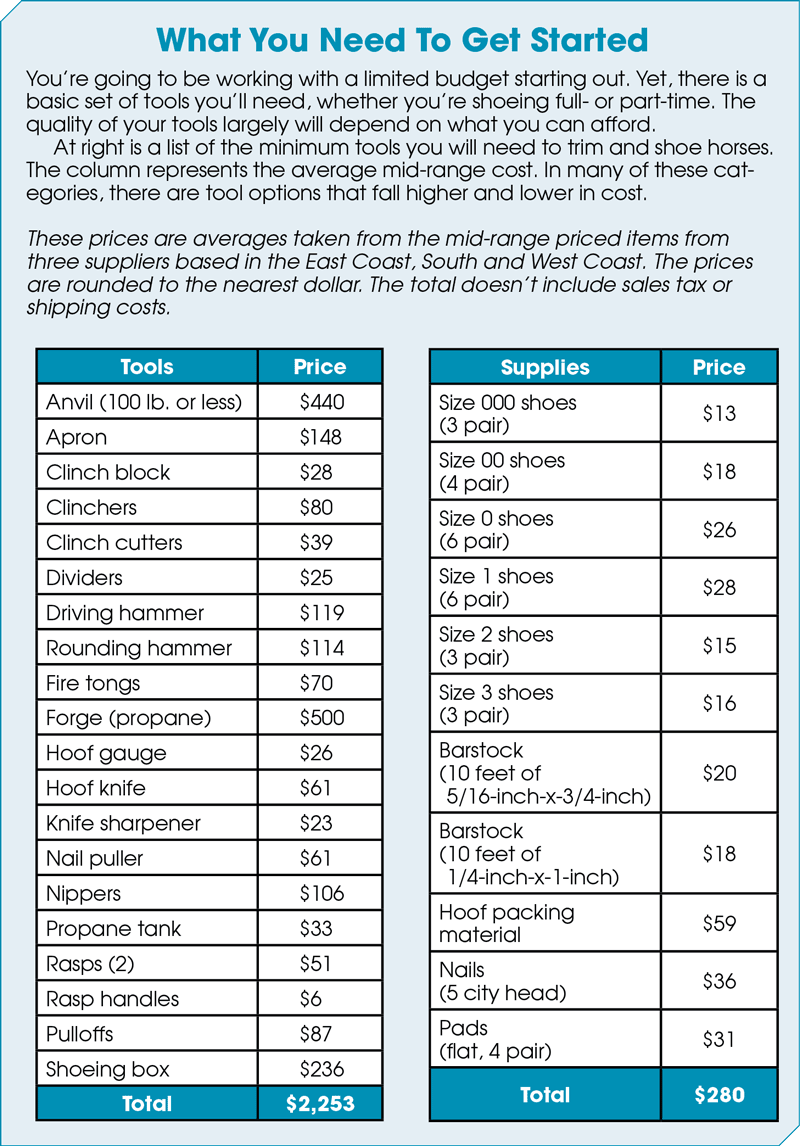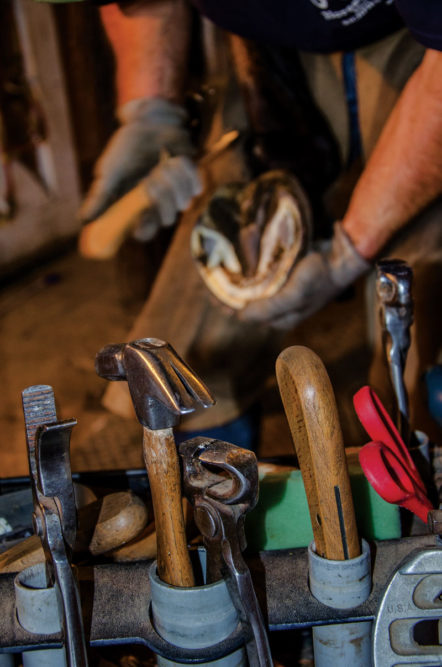Pictured Above: It’s important to select reliable tools that will withstand the rigors of day-to-day farriery.
What’s a better way to celebrate the dawn of your farrier career than tool shopping?
There’s no doubt that the temptation runs high to grab the top-of-the-line pair of nippers that are polished so brightly that a pair of sunglasses should come standard with them. While the feel and performance of a high-quality tool often are worth the price, many young farriers have a steep financial mountain to climb when starting out.
“Young people, especially those coming out of school, need to budget their money,” advises Lucedale, Miss., farrier Dan Bradley, a clinician for GE Forge & Tool. “You can’t compare the cost of being in the business now to what it was in the early ’70s or late ’60s. Buy a tool now that’s a little less expensive and budget money for down the road to be able to get the more expensive tool.”
Doing your homework before buying tools and supplies can save you money and ensure that you’re buying what you need.
Improving your forging skills can save you money and limit the amount of horseshoes you have to carry around.
Regular maintenance and proper treatment will help protect your investment by extending the life of your tools.
Yet, there’s an adage that many farriers live by — you get what you pay for.
“Good tools are not expensive,” says Bob Schantz, owner of Spanish Lake Blacksmith Shop, “cheap
tools are.”
Do You Need It?
Resisting the impulse buy is important for another reason — you might not need it.
“Largely, it depends on what level of work you are doing — not the quality of your work, but how many and the type of horses you are working with,” says Danny Ward, owner of the Danny Ward Horseshoeing School in Martinsville, Va. “Your goal is to find reliable, professional tools that will hold up to the day-to-day wear and tear.”
To get a better idea about tools and supplies, don’t be shy about approaching those who know — farrier school instructors and experienced farriers.
“Usually the person who is teaching the trade will be a good source of information on what tools and initial supplies a new farrier will need,” Schantz says. “Asking other farriers what shoe styles and sizes are most common in the area they will be shoeing in is a good way to get the right products.”
One way to reduce costs is by relying on your skills at the anvil.
“I know of one experienced farrier who recommends that young farriers buy only size 0 and 2 plain horseshoes,” recalls the International Horseshoeing Hall Of Famer. “He says that forces them to use their forge to crop heels on the 0s if they need a 00, and on the 2s if they need a size 1. He feels this method gives them the full line of shoe sizes since the last nail holes in many of the shoes are not used anyway.”
Tips To Save Money On Tools
Supply shops often give discounts for bulk purchases. It might make more sense to join with other farriers to form a buying co-op. If you have similar needs in supplies, you can combine your money to get the items you need, receiving the discount without shouldering the entire purchase cost.
Before you buy, determine whether the amount of supplies and the money tied up in the purchases are worth the discount. For instance, if you spend a significant amount and it takes more than a year to use that inventory, was the discount worth the negative effect on your cash flow?
Another consideration is to shop around online. Fill the online carts with all of your needs and compare the total prices. You might find one supplier stands out from others.
Let’s Go Shopping
Once you’ve figured out what tools and supplies you need, it’s time to make friends with your supply shop.
“More often, people are using the Internet to buy from manufacturers and suppliers,” Ward says. “Don’t forget, supplies and tools aren’t light stuff. If shipping costs are involved, it might be cheaper to buy from a local supplier at the brick and mortar store.”
If you decide to buy online, be sure to comparison shop.
“When it is time to buy, bring up the online suppliers you will normally use and click on everything on your shopping list,” says the Hall Of Fame farrier. “You’ll see your entire purchase there, down to the shipping cost. After you do this with all of the suppliers, you’ll find the best prices. You can usually find deals like free or discounted shipping if you buy above a certain dollar amount.”
While exercising your critical shopping skills, be sure you are doing so safely.
“Make sure that the payment section of the website is secured by one of the major companies such as VeriSign and Authorize.net,” Schantz advises. “Find out the return and shipping policies such as restocking fees and back orders.”
A farrier also can maximize the value of purchases by using credit cards that offer rewards.
“I know a farrier who pays for all of his supplies with an airline credit card,” says the Foristell, Mo., farrier. “He buys a month’s worth of supplies shortly after the closing of the card each month. He then has 30 days before the bill comes and another 30 days before he has to pay it. He and his wife take trips to Ireland every couple of years with airline tickets paid with the points he accumulates from buying gas and farrier supplies.”
Make Your Tools Last
When plopping down your hard-earned cash to buy tools, it’s wise to protect that investment to ensure peak performance and longevity.
“The best way to extend the lives of your tools is to use them for what they are designed for,” Ward says. “Using a hoof and wire brush to clean dirt and rocks from a hoof prior to trimming will save wear and tear on your hoof knife, nippers and rasps.”
Good tools are not expensive, cheap tools are …
Proper storage, treatment and use will help you get more bang for your buck.
“Carelessness or rough treatment of any tool,” Schantz says, “will shorten its life.”
Regular maintenance, particularly with riveted tools, will help keep more money in your pocket.
“I just use 3-in-One Oil on my riveted tools,” Bradley says. “It’s a real light machine oil. If you’re going to take care of the rivet, you just open it up and run a bead across the rivet.”
The more humid regions of the country will require a little more attention.
“Once you clean up the tool,” he says, “just wipe it down with a light oil or whatever to keep the rust off.”
Many companies offer rebuilding services for half the price of a new tool. However, a handy do-it-yourselfer can save money rebuilding a tool, or making a new one.
“Be creative, but not dangerous,” Ward says. “Make sure your investment in a handmade tool doesn’t exceed what you would pay a supplier for. When they are absolutely worn out, make something else out of your tools. Give them new life. For example, clinchers make great tongs and nippers make good hoof testers.”










Post a comment
Report Abusive Comment